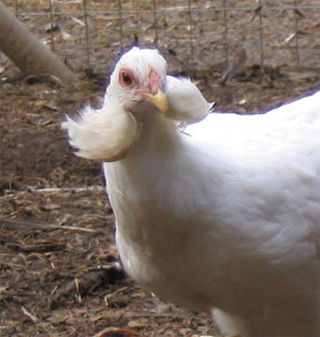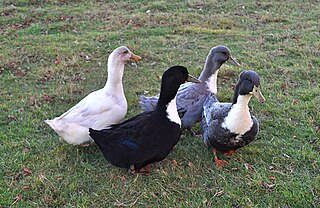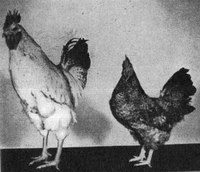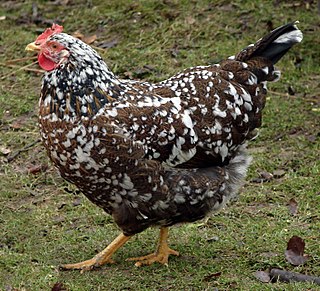
The Yurlov Crower is an old Russian breed of chicken primarily selected and used for long crowing cock contests in Russia.

The Yurlov Crower is an old Russian breed of chicken primarily selected and used for long crowing cock contests in Russia.

The Yurlov Crower breed was presumably created in the second half of 19th century by crossing Chinese meat-type breeds, fighting cocks and landraces, but doubtfully with the direct influence of the Malay breed. According to Moiseyeva (1992), the known breed's plumage color variants are white, silver, scarlet, black with light yellow, or golden, hackle (most of all), and black.
The breed was a subject of interest among fancy, commercial and state breeders in Russia and Ukraine for a long time in the 20th century. It has been preserved and studied at few state poultry collection farms since the 1970s–1980s. The Geflügel-Börse magazine articles published by two German writers, Rüdiger Wandelt in 1993 and Wolfgang Vits in 1994, introduced the breed to poultry fanciers in Germany. However, the breed was not well known until recent time to a broad community of Western poultry breeders. The continued contacts between German and Russian poultry breeders in the 1990s and 2000s led to the import of the Yurlov Crower breed to Western Europe and growth of its popularity first in Germany and then in other European countries.
According to the USSR Central Statistic Administration, there were only 200 Yurlov chickens registered in the entire Soviet Union by 1985 (Moiseyeva, 1992). After the USSR disintegration, the breed population in independent Russian Federation, Ukraine and other republics dramatically declined. Based on the data collected in 1993, a Ukrainian strain of Yurlov Crowers (line 92) was included in the second edition of the FAO's World Watch List in 1995 (Scherf, 1995). The breed and line 92 data were also summarized in the third edition of the WWL in 2000 (Scherf, 2000), in which, as of 1993, only 205 Yurlov birds (line 92) kept in Kharkov Region of Ukraine were mentioned and the population status was endangered. The current population of the Yurlov Crower chickens in Russia and Ukraine may be several thousands including both state farms and fanciers. However, bird influenza may represent a serious threat to and decrease numbers of pure chicken breeds (including Yurlovs) in these countries to a large extent.
The breed was included in the studies of genetic diversity and relationships between various chicken breeds:
The latter study was done in 1998—2000 within the framework of an international research project entitled «Development of Strategy and Application of Molecular Tools to Assess Biodiversity in Chicken Genetic Resources», or shortly AVIANDIV, that was sponsored by European Commission and co-ordinated by Prof. Steffen Weigend, of the Institute for Animal Breeding, Mariensee, Germany.
The AVIANDIV project employed anonymous genetic markers, so called microsatellite loci spread across the whole genome. It was shown that 33 populations had no unique alleles, 14 populations had one unique allele, but the Yurlov Crower from Russia has 8 unique alleles. That the Ukrainian population of Yurlov Crowers did not have any unique alleles, that is, had remarkably different genetic features. Overall, the Russian Yurlov Crower population became one of three the most diverse, or polymorphic, populations in the study, along with a wild red junglefowl population and a broiler dam line.

Poultry are domesticated birds kept by humans for the purpose of harvesting useful animal products such as meat, eggs or feathers. The practice of raising poultry is known as poultry farming. These birds are most typically members of the superorder Galloanserae (fowl), especially the order Galliformes. The term also includes waterfowls of the family Anatidae and other flying birds that are kept and killed for their meat such as the young pigeons, but does not include wild birds hunted for food known as game or quarry.

The American Game is an American breed of game fowl, chickens bred specifically for cockfighting. It has many color varieties, and may also be kept for ornament.

The Araucana is a breed of domestic chicken from Chile. Its name derives from the Araucanía region of Chile where it is believed to have originated. It lays blue-shelled eggs, one of very few breeds that do so.
Rumpless chickens are characterised by caudal dysplasia, the absence of the pygostyle or caudal appendage – the "parson's nose". This is the result of inheritance of an autosomal dominant trait. The mutation which causes it is unknown; two candidates have been proposed.

The Malay Game is a breed of game chicken. It is among the tallest breeds of chicken, and may stand over 90 cm high.

The Poltava is an old Ukrainian dual-purpose breed of chicken named after the Ukrainian city of Poltava. It includes three color varieties: Clay, Cuckoo, and Black.

The Swedish Blue or Blue Swedish is a Swedish breed of domestic duck. It originated in the former dominion of Swedish Pomerania – now in north-west Poland and north-east Germany – and is documented there from 1835. It is closely similar to the Pomeranian Duck from the same general area, differing mainly in its white primary feathers.

The Ukrainian Grey is an ancient Ukrainian breed of Podolian cattle. It is a hardy breed, and was traditionally used both for meat and for draught power. It is similar to other European steppe cattle breeds such as the Hungarian Grey and the Italian Podolica.

The Buckeye is an American breed of chicken. It was created in Ohio in the late nineteenth century by Nettie Metcalf. The color of its plumage was intended to resemble the color of the seeds of Aesculus glabra, the Ohio Buckeye plant for which the state is called the 'Buckeye State'.
The Ixworth is an English breed of white domestic chicken. It is named for the village of Ixworth in Suffolk, where it was created in 1932. It was bred as fast-growing high-quality meat breed with reasonable laying abilities.

The Asil or Aseel is an Indian breed or group of breeds of game chicken. It is distributed in much of India, particularly in the states of Tamil Nadu, Andhra Pradesh, Chhattisgarh and Odisha; it has been exported to several other countries. Similar fowl are found throughout much of Southeast Asia.

The Bergische Kräher is a German breed of domestic chicken from the Bergisches Land, in the state of North Rhine-Westphalia in western Germany. It is named for its unusually long crow, up to five times as long as that of other breeds, and belongs to the group of long-crowing chicken breeds, which are found from south-east Europe to the Far East.

Delayed-feathering in chickens is a genetically determined delay in the first weeks of feather growing, which occurs normally among the chicks of many chicken breeds and no longer manifests itself once the chicken completes adult plumage.

Solid black plumage color refers to a plumage pattern in chickens characterized by a uniform, black color across all feathers. There are chicken breeds where the typical plumage color is black, such as Australorp, Sumatra, White-Faced Black Spanish, Jersey Giant and others. And there are many other breeds having different color varieties, which also have an extended black variety, such as Leghorn, Minorca, Wyandotte, Orpington, Langshan and others.

Dwarfism in chickens is an inherited condition found in chickens consisting of a significant delayed growth, resulting in adult individuals with a distinctive small size in comparison with normal specimens of the same breed or population.

The Swedish Flower Hen, Swedish: Skånsk Blommehöna, is an endangered traditional Swedish breed of domestic chicken. It is one of eleven traditional chicken breeds in Sweden.

Long-crowing chicken breeds are characterised by the unusually long-drawn-out crow of the cocks, which may in some cases last for up to 60 seconds. The oldest references to long-crowing cocks are from China. Long-crowing breeds are found in the Far East, in Turkey, in the Balkans and in western Germany.

Alexander Sergeevich Serebrovsky was a Russian geneticist, poultry breeder, and eugenicist. He was among the founding figures of genetics within the early days of the Soviet Union and held a high status within the communist party but when Soviet genetics entered a power struggle, he was targeted for his ideas in eugenics which led to the sidelining of his career although he was not executed like several other geneticists during the purges under Stalin. Serebrovsky is credited with defining the term genofond from which the English term gene pool is derived. He was also the pioneer of the theory on which the sterile male technique of pest management is based.

The Appenzeller Barthuhn is a Swiss breed of bearded chicken originating in the historical Appenzell region of Switzerland. It is one of two chicken breeds from that area, the other being the Appenzeller Spitzhauben; the only other Swiss breed of chicken is the Schweizer.